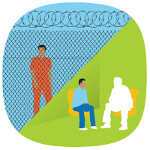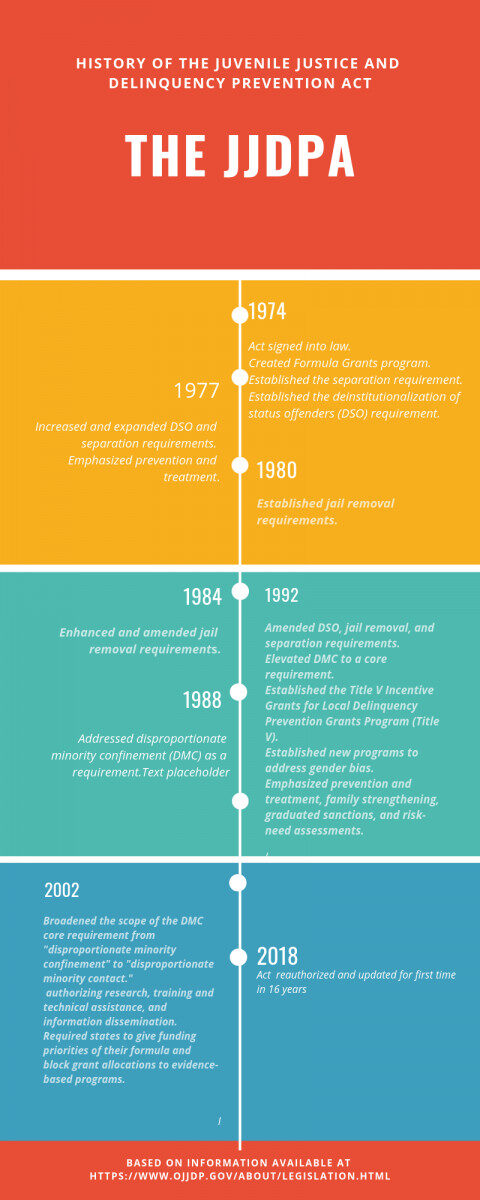Juvenile Justice and Delinquency Prevention Act
History of the JJDPA
Established in 1974 and most recently authorized in 2018 with bipartisan support, the Juvenile Justice and Delinquency Prevention Act (JJDPA) is based on a broad consensus that children, youth, and families involved with the juvenile and criminal courts should be guarded by federal standards for care and custody, while also upholding the interests of community safety and the prevention of victimization.
The Juvenile Justice and Delinquency Prevention Act (JJDPA) provides for:
- A nationwide juvenile justice planning and advisory system spanning all states, territories, and the District of Columbia
- Federal funding for delinquency prevention and improvements in state and local juvenile justice programs and practices
- The operation of a federal agency, the Office of Juvenile Justice and Delinquency Prevention, which is dedicated to training, technical assistance, model programs, and research and evaluation, to support state and local efforts
The JJDPA has Four Core Requirements:

Deinstitutionalization of Status Offenders
Status offenses are offenses that only apply to minors whose actions would not considered offenses if they were adults. The most common are skipping school, running away, breaking curfew, and possession or use of alcohol. Under the JJDPA, status offenders may not be held in secure detention or confinement.
There are, however, several exceptions to this rule, including allowing some status offenders who are in violation of a valid court order, to be detained. The DSO provision seeks to ensure that status offenders who have not committed a criminal offense are not held in secure juvenile facilities for extended periods of time or in secure adult facilities for any length of time. These children, instead, should receive community-based services, such as day treatment or residential home treatment, counseling, mentoring, family support, and alternative education. Learn more in the Deinstitutionalization of Status Offenders Fact Sheet.

Adult Jail and Lock-up Removal
Under the JJDPA, youth may not be detained in adult jails and lock-ups except for limited times before or after a court hearing (6 hours), in rural areas (24 hours plus weekends and holidays), or in unsafe travel conditions. This provision is designed to protect children from psychological abuse, physical assault, and isolation. Children housed in adult jails and lock-ups have been found to be eight times more likely to commit suicide, two times more likely to be assaulted by staff, and 50 percent more likely to be attacked with a weapon than children housed in juvenile facilities. Learn more in Act 4 JJ’s Jail Removal/Sight and Sound Separation Fact Sheet .

Sight and Sound Separation
When children are placed in an adult jail or lock-up, “sight and sound” contact with adults is prohibited under the JJDPA. This provision seeks to prevent children from threats, intimidation, or other forms of psychological abuse and physical assault. Under “sight and sound,” children cannot be housed next to adult cells, share dining halls, recreation areas, or any other common spaces with adults, or be placed in any circumstance that could expose them to threats or abuse from adult offenders. Learn more in Act 4 JJ’s Jail Removal/Sight and Sound Separation Fact Sheet.

Racial and Ethnic Disparities
Under the JJDPA, states are required to assess and address racial and ethnic disparities at key points in the juvenile justice system – from arrest to detention to confinement. Studies indicate that youth of color receive tougher sentences and are more likely to be incarcerated than white youth for the same offenses. With youth of color comprising one-third of the youth population but two-thirds of youth in contact with the juvenile justice system, this provision requires states and local jurisdictions to create action plans to address disparities within their systems. Learn more in Act4JJ’s Racial and Ethnic Disparities Fact Sheet.
The Importance of a Federal-State Partnership with State and Local Jurisdictions
Given that there are hundreds of different juvenile justice systems throughout the U.S. states and territories, it is critical that juvenile justice have a dedicated focus and a “home” within federal government. This department would serve the purposes of developing national policies, objectives, priorities, and plans, and for providing guidance, support, and oversight to states/territories in implementing the JJDPA. The Office of Juvenile Justice and Delinquency Prevention (OJJDP) is the agency charged with responsibility for juvenile justice at the U.S. Department of Justice. OJJDP carries out its purposes through research, policies, and grants to states and localities. These grants assist them in planning, establishing, operating, coordinating, and evaluating projects for the development of more effective education, training, research, prevention, diversion, treatment, and rehabilitation in the areas of juvenile delinquency prevention and systems improvements.
Similarly, it is imperative that the states be in constant and collaborative contact with the federal government in order to develop strategies that work for the states, meet local needs, and lead to best and promising practices for children, youth, and communities across the nation. The SAGs fulfill this role, individually and collectively, by:
- Embodying models for collaborative systems change
- Providing real-world advice and counsel to their respective Governors and state legislatures, as well as the President and the U.S. Congress
- Serving as incubators for cost-effective innovations that create optimal outcomes for the prevention of delinquency
Reauthorization of the JJDPA
First enacted in 1974, the Juvenile Justice and Delinquency Prevention Act (JJDPA) was reauthorized in December 2018 for the first time in nearly 16 years. H.R. 6964 received broad bipartisan support. The legislation provides long awaited updates to the Act and its core protections, and reflects the new knowledge that has developed in the field. The JJDPA remains one of the most successful standard-setting statutes at the federal level and at its heart recognizes the value of citizen-driven efforts to prevent and stem delinquency. The success of the JJDPA has been supported in significant part by the national agenda-setting, research, evaluation, oversight, and technical assistance functions of OJJDP. It remains the landmark federal statute—and single most influential piece of federal legislation—providing four substantive safeguards (core protections) for youth who come into contact with the juvenile justice system.
For a copy of the revised text of the JJDPA, click here.
Resources:
CJJ’s Policy Platform Supporting JJDPA Reauthorization
JJDPA Redline
SAG Membership Checklist
SAG Membership Fact Sheet
SAG Membership Redline
Summary of H.R. 6964
Text of H.R. 6964
Webinar recording and slides: What’s Next: H.R 6964 and the Reauthorization of JJDPA
Issue Specific Fact Sheets:
Data Collection Requirements
Deinstitutionalization of Status Offenders
Funding
Reentry
State Plans
For additional resources and fact sheets, visit act4jj.org/resources.
